Santiago de Compostela Cathedral
| Santiago de Compostela Cathedral | |
|---|---|
|
The Western façade of the cathedral as seen from the Praza do Obradoiro. | |
| Basic information | |
| Location | Santiago de Compostela, Galicia, Spain |
| Geographic coordinates | 42°52′50″N 8°32′40″W / 42.880602°N 8.544377°WCoordinates: 42°52′50″N 8°32′40″W / 42.880602°N 8.544377°W |
| Affiliation | Roman Catholic |
| District | Santiago de Compostela |
| Heritage designation | 1896, 1985 |
| Leadership | Archbishop Julián Barrio Barrio |
| Website | www.catedraldesantiago.es |
| Architectural description | |
| Architectural type | Cathedral |
| Architectural style | Romanesque, Gothic, Baroque |
| Groundbreaking | 1060 |
| Completed | 1211 |
| Specifications | |
| Direction of façade | West |
| Capacity | 1,200 |
| Length | 100 metres (330 ft) |
| Width | 70 metres (230 ft) |
| Spire(s) | 2 |
| Official name: Santiago de Compostela (Old Town) | |
| Criteria | i, ii, vi |
| Designated | 1985[1] |
| Reference no. | 320bis |
| Official name: Catedral Igrexa Catedral Metropolitana | |
| Designated | 22 August 1896 |
| Reference no. | (R.I.) - 51 - 0000072 - 00000 [2] |
_Westfassade_der_Kathedrale.jpg)
The Cathedral of Santiago de Compostela (Galician: Catedral de Santiago de Compostela), a cathedral of the archdiocese is in the World Heritage Site of Santiago de Compostela in Galicia in Spain. The cathedral is the reputed burial-place of Saint James the Great, one of the apostles of Jesus Christ. The cathedral has historically been a place of pilgrimage on the Way of St. James, since the Early Middle Ages. The building is a Romanesque structure with later Gothic and Baroque additions.
History
According to legend, the apostle Saint James the Great brought Christianity to the Iberian Peninsula.[3][4] In 44 CE he was beheaded in Jerusalem. His remains were later brought back to Galicia, Spain.[5] Following Roman persecutions of Spanish Christians, his tomb was abandoned in the 3rd century. According to legend, this tomb was rediscovered in 814 AD by the hermit Pelagius, after he witnessed strange lights in the night sky. Bishop Theodomirus of Iria recognized this as a miracle and informed king Alfonso II of Asturias and Galicia (791-842). The king ordered the construction of a chapel on the site. Legend has it that the king was the first pilgrim to this shrine. This was followed by the first church in 829 AD and then in 899 AD by a pre-Romanesque church, ordered by king Alfonso III of León,[6] which caused the gradual development of the major place of pilgrimage.[7]
In 997 the early church was reduced to ashes by Al-Mansur Ibn Abi Aamir (938-1002), army commander of the caliph of Córdoba. The Al-Andalus commander was accompanied on his raid by his vassal Christian lords, who received a share of the loot, while St James' tomb and relics were left undisturbed. The gates and the bells, carried by local Christian captives to Córdoba, were added to the Aljama Mosque.[8] When Córdoba was taken by king Ferdinand III of Castile in 1236, these same gates and bells were then transported by Muslim captives to Toledo, to be inserted in the Cathedral of Saint Mary of Toledo.
Construction of the present cathedral began in 1075 under the reign of Alfonso VI of Castile (1040–1109) and the patronage of bishop Diego Peláez. It was built according to the same plan as the monastic brick church of Saint Sernin in Toulouse, probably the greatest Romanesque edifice in France. It was built mostly in granite. Construction was halted several times and, according to the Liber Sancti Iacobi, the last stone was laid in 1122. But by then, the construction of the cathedral was certainly not finished. The cathedral was consecrated in 1211 in the presence of king Alfonso IX of Leon.[9][10]
According to the Codex Calixtinus the architects were "Bernard the elder, a wonderful master", his assistant Robertus Galperinus and, later possibly, "Esteban, master of the cathedral works". In the last stage "Bernard, the younger" was finishing the building, while Galperinus was in charge of the coordination. He also constructed a monumental fountain in front of the north portal in 1122.
The church became an episcopal see in 1075 and, due to its growing importance as a place of pilgrimage, it was soon raised to an archiepiscopal see by pope Urban II in 1100. A university was added in 1495.
The cathedral was expanded and embellished with additions in the 16th, 17th and 18th centuries.
Exterior of the cathedral

Each of the façades along with their adjoining squares constitute a magnificent urban plaza. The Baroque façade of the Obradoiro square was completed by Fernando de Casas Novoa in 1740. Also in baroque style is the Acibecharía façade by Ferro Caaveiro and Fernández Sarela, later modified by Ventura Rodríguez. The Pratarías façade, built by the Master Esteban in 1103, and most importantly the Pórtico da Gloria, an early work of Romanesque sculpture, were completed by Master Mateo in 1188.
Pórtico da Gloria
_Portico_de_la_G_loria_in_der_Kathedrale.jpg)
The Pórtico da Gloria ("portico of the glory" in Galician) of the Cathedral of Santiago de Compostela is a Romanesque portico by Master Mateo and his workshop commissioned by King Ferdinand II of León. To commemorate its completion in 1188, the date was carved on a stone and set in the cathedral, and the lintels were placed on the portico. Finalising the complete three-piece set took until 1211, when the temple was consecrated in the presence of King Alfonso IX of León.[9][11]
The portico has three round arches that correspond to the three naves of the church, supported by thick piers with pilasters. The central arch, twice as wide as the other two, has a tympanum and is divided by a central column—a mullion—containing a depiction of Saint James. Vertically, the lower part is formed by the bases of the columns, decorated with fantastic animals, the middle portion consists of columns adorned with statues of the Apostles and the upper part supports the base of the arches crowning the three doors. The sculpture is intended to serve as an iconographic representation of various symbols derived from the Book of Revelation and books of the Old Testament.[12]
Tympanum
The arrangement of the tympanum is based on the description of Christ that John the Evangelist makes in Revelation (Chapter 1 v 1 to 18). In the centre, the Pantocrator is shown, with the image of Christ in Majesty, displaying in his hands and feet the wounds of crucifixion. Surrounding Christ, the tetramorph with the figures of the four Evangelists with their attributes: left, top St. John and the eagle and below St. Luke with the ox, on the right, above St. Matthew on the hood of the tax collector and below St. Mark and the lion.[13]
On both sides of the evangelists, behind Mark and Luke, are four angels on each side with the instruments of the Passion of Christ. Some are, without touching them directly, the cross and crown of thorns (left) and lance and four nails (right), another the column in which he was whipped and the jar with which he was washed Pontius Pilate. Above the heads of these angels, two large groups of souls of the blessed, forty in all. In the archivolt of the central tympanum are seated the elders of the Apocalypse, each holding a musical instrument, as if preparing a concert in honor of God.[13]

Mullion
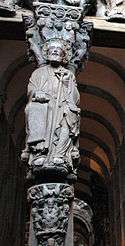
In the mullion is the seated figure of Saint James with a pilgrim's swagger stick, as patron of the basilica. St. James appears with a scroll which contains written Misit me Dominus (the Lord sent me). The column just above his head with a capital which represents the temptations of Christ. On three of its sides, facing the inside of the temple, two kneeling angels pray. At the foot of the saint is another capital with the figures of the Holy Trinity. Under the Apostle represents the tree of Jesse, the name given to the family tree of Jesus Christ from Jesse, father of King David, is the first time that this subject is represented in religious iconography in the Iberian Peninsula. The column rests on a base where there is a figure with beard to his chest (perhaps an image of Noah) and two lions. At the foot of the central column at the top inside looking towards the main altar of the cathedral, is the kneeling figure of the himself Master Mateo, holding a sign that is written Architectus. This image is popularly known as «Santo dos croques»[14] by the ancient tradition of students from hitting their heads against the figure for wisdom, a tradition that was adopted later by pilgrims, although steps are being taken to limit access to try to stop the deterioration that is why the work has suffered.
Jambs

In the columns of the central door and two side doors apostles are represented, as well as prophets and other figures, with their iconographic attributes. All are topped with its own capital which represent different animals and human heads with leaf motifs. All figures were multicolored and with his name on the books or scrolls they hold in their hands.
The four pillars of the portico are based on strong foundations which represent various groups of animals and human heads with beards. For some authors, these figures are images of demons, and symbolize the weight of glory (the portico in this case) crushes sin. Other sources give an apocalyptic interpretation, with wars, famine and death (represented by the beasts), situations that can only be saved by human intelligence (the heads of older men).
Side doors
The arch of the right door represents the Last Judgment. The double archivolt is divided into two equal parts by two heads. Some authors identify these heads with the figures of archangel Michael and Christ, for others they are Christ-Judge and an angel, and other sources indicate that represent God the Father and God the Son. To the right of these heads is represented the Hell, with figures of monsters (demons) that drag and torture the souls of the damned. On the left, the Heaven with the elect, with figures of angels with children symbolizing the saved souls.[15][16]
The arch of the left door depicts scenes from the Old Testament, with the righteous await the arrival of the Savior. In the center of the first archivolt is God the Creator who blesses the pilgrim and holding the Book of Eternal Truth, to his right is Adam (naked), Abraham (with the index raised) and Jacob. With them are two figures that could be Noah (new father of humanity to save the Flood) and Esau or Isaac and Judah. To the left of God it see Eve, Moses, Aaron, King David and Solomon. In the second archivolt, the top, ten small figures representing the twelve tribes of Israel.[13]
Façade of the Obradoiro

The Obradoiro square in front of the façade alludes to the workshop (obradoiro, in Galician) of stonemasons who worked on the square during the construction of the cathedral. In order to protect the Pórtico da Gloria from deterioration caused by weather, this façade and towers have had several reforms since the 16th century. In the 18th century it was decided to build the current Baroque façade, designed by Fernando de Casas Novoa. It has large glazed windows that illuminate the ancient Romanesque façade and is located between the towers of the Bells and of the Ratchet. In the middle of the central body is St. James and one level below his two disciples Athanasius and Theodore, all dressed as pilgrims. In between, the urn (representing the found tomb) and the star (representing the lights he saw the Hermit Pelagius) between angels and clouds. The tower on the right depicts Mary Salome, mother of St. James, and the tower on the left depicts his father Zebedee. The balustrade on the left side depicts St. Susanna and St. John and the one on the right depicts St. Barbara and James the Less.[17]
A stair allows reaching the entrance of the façade. The stair was made in the 17th century by Ginés Martínez and it is of Renaissance style inspired by Giacomo Vignola of Palazzo Farnese. It is diamond-shaped with two ramps that surround the entrance to the old 12th century Romanesque crypt of the Master Mateo, popularly called the "Old Cathedral".[18]
Between the existing plane of the façade of the Obradoiro and the old Romanesque portal (Pórtico da Gloria) there is a covered narthex.
This façade has become a symbol of the cathedral and the city of Santiago de Compostela. As such, it is the engraving on the back of the Spanish euro coins of 1, 2 and 5 cents.
South façade or das Pratarías
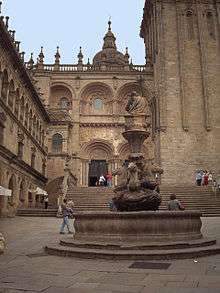
The façade of the Silverware (Pratarías in Galician) is the southern façade of the transept of the cathedral of Santiago de Compostela and is the only Romanesque façade that is preserved in the cathedral. It was built between 1103 and 1117 and elements from other parts of the cathedral have been added in subsequent years.[19] The square is bound by the cathedral and cloister on two sides. Next to the cathedral is the Casa do Cabido.
It has two entrance doors in degradation with archivolts and historian tympanums. The archivolts are attached over eleven columns, three are of white marble (middle and corners) and the rest of granite. In the center are the figures of twelve prophets and the Apostles on the sideline. On the tympanums is a large frieze is separated from the upper body by a strip supported by grotesque corbels, on this floor are two windows that are decorated with Romanesque archivolts.[19]

In the central frieze is Christ, with various characters and scenes. On the right six figures belong to the choir of Master Mateo that were placed in the late 19th century. The original provision of the iconographic elements was invalidated since that 18th century numerous images were introduced recovered from the dismantled Acibecharía facade.[20] A central medallion shows the Eternal Father (or Transfiguration) with open hands and on the top surface there are four angels with trumpets heralding the Final Judgment.[19]
In the tympanum of the left door is Christ tempted by a group of demons. To the right is a half-dressed woman with a skull in her hands, which could be Eve or the adulterous woman. This figure is not praying on her knees but is sitting on two lions. The jambs are Saint Andrew and Moses. In the left abutment, the Biblical King David seated on his throne with his legs crossed, translucent through the thin fabric of his clothes, and playing what appears to be a rebec, personifies the triumph over evil and is an outstanding work of the Romanesque, sculpted by Master Esteban. The creation of Adam and Christ's blessing is also shown. Many of these figures come from the Romanesque façade of the north or do Paraíso (current façade of the Acibecharía) and were placed on this façade in the 18th century.[19][21]
In the tympanum of the right door there are several scenes from the Passion of Christ and the Adoration of the Magi. In one of the jambs is the inscription commemorating the laying of the stone:
Registration follows the Roman calendar, according to the computation of the call Spanish era, corresponding to July 11, 1078. An image, unidentified, on a fox eats a rabbit and, against this, a badly dressed woman with an animal in her lap, comes from elsewhere. Supported on the wall of the tower Berenguela appear other images representing the creation of Eve; Christ on a throne and the Binding of Isaac.[19]
North façade or da Acibecharía
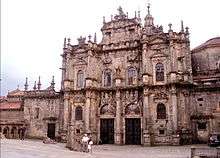
The façade "da Acibecharía" (Galician name derived from the jet gemstone) is in the Praza da Inmaculada or Acibecharía, draining the last section of urban roads: French, Primitive, Northern and English through the old gate Franxígena or Paradise door. The Romanesque portal was built in 1122 by Bernardo, treasurer of the temple. This portal was demolished after suffering a fire in 1758, some sculptural pieces that were saved were placed on the façade das Pratarías. The new façade was designed in Baroque style by Lucas Ferro Caaveiro and finished by Domingo Lois Monteagudo and Clemente Fernández Sarela in the neoclassical style in 1769, although it retained some traces of the baroque.[22]
At the top of the façade is an 18th-century statue of St. James, with two kings at his feet in prayer: Alfonso III of Asturias and Ordoño II of León. In the centre is the statue of Faith.[23][24]
East façade or da Quintana

The façade of the cathedral that overlooks the Quintana Square has two gates: the Porta Real (royal gate) and the Porta Santa (holy gate). The construction of the Porta Real, baroque, begun under the direction of José de Vega y Verdugo and by José de la Peña de Toro in 1666, and was completed by Domingo de Andrade in 1700, who built some of the columns that span two floors of windows, a balustrade with large pinnacles and an aedicula with an equestrian statue of Saint James (now disappeared), well adorned with decorative fruit clusters and large-scale military trophies. The kings of Spain entered the cathedral through this door, hence its name, and on its lintel is the royal coat of arms.[19][25]
The so-called Holy Door (Porta Santa) or Door of Forgiveness (Porta do Perdón) is the closest to the steps, is usually closed with a fence and opened only in Jubilee Years (years when St James's Day (25 July) falls on a Sunday). It was one of the seven lesser gates and was dedicated to St. Pelagius (whose monastery is just opposite). On this door niches contain the image of James and his disciples Athanasius and Theodore at his side. On the bottom and sides of the door were placed twenty-four figures of prophets and apostles (including St. James) coming from the old stone choir of Master Mateo. Inside this door through a small courtyard is the true Holy Door, which enters into the ambulatory of the apse of the church.[19][26]
Bell Towers

The early towers were in the main façade of the cathedral were Romanesque (current façade of the Obradoiro). They are called the Torre das Campás, which is situated on the side of the Epistle (right) and Torre da Carraca, to the side of the Gospel (left). The two have a height of between 75 and 80 metres.[27]
The first part of the tower was built in the 12th century, but in the 15th century several modifications were made and King Louis XI of France donated in 1483 the two largest of the thirteen bells.[28]
Due to a tilt that was detected in its structure between the 16th and 17th centuries, the towers had to be reinforced with buttresses, between 1667 and 1670. José de la Peña made the body in baroque style in which the bells are housed, and which was completed by Domingo de Andrade. The architecture of the towers has a great effect in perspective with its vertical lines and the sequencing of its floors.[29][30]
North Tower or da Carraca
It is located to the left of the façade del Obradoiro, and was built - like its partner - on the opposite side of an earlier tower of the Romanesque period. It was designed by Fernando de Casas Novoa in 1738, imitating the Torre das Campás by Peña del Toro and Domingo de Andrade in the 17th century: baroque decorations adorned all kinds of ornamentation that provided a unifying architecture across the façade.[29]
Clock Tower, Torre da Trindade or Berenguela
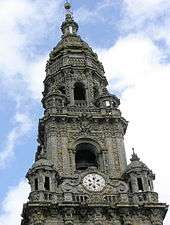
The Clock Tower, also called Torre da Trindade or, Berenguela, is at the intersection of the Pratarías square and the Quintana square. Traditionally, construction was thought to begin in 1316, at the request of Archbishop Rodrigo de Padrón as a defence tower. After his death his successor, Archbishop Bérenger de Landore, continued to work on it, although some authors argue that these dates may not be correct.[28] When he became main master of the cathedral, Domingo de Andrade continued with its construction and between 1676 and 1680 raised it two floors more; the use of various structures achieved a harmonious and ornamental design with a pyramid-shaped crown and a lantern as a final shot (inside of which four light bulbs stay on permanently). It rises to seventy-five metres.[30]
In 1833 a clock was placed in four areas (one for each side of the tower), work by Andrés Antelo, and had been commissioned by the Archbishop Rafael de Vélez. As part of its mechanism it has two bells, the hour hand, called Berenguela, and a smaller one that marks the quarter. These two were cast in 1729 by Güemes Sampedro, Berenguela, and have a diameter of 255 cm and a height of 215 cm, weighing approximately 9,600 kilos, and 1,839 kilos with a diameter of 147 cm and a height of 150 cm, respectively. Both bells cracked, forcing their replacement. The current replicas were cast in Asten (Netherlands) by the Eijsbouts house in 1989 and were placed in the cathedral in February 1990.[31][32]
Interior
The cathedral is 97 m long and 22 m high. It preserves its original barrel-vaulted cruciform Romanesque interior. It consists of a nave, two lateral aisles, a wide transept and a choir with radiating chapels. Compared with many other important churches, the interior of this cathedral gives a first impression of austerity until one enters further and sees the magnificent organ and the exuberance of the choir. This cathedral, through its monumental dimensions, is the largest Romanesque church in Spain and even one of the largest in Europe.
The Pórtico da Gloria
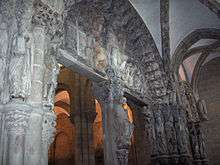
The 12th-century Portico da Gloria, behind the western façade, is in the narthex of the west portal. It is a remain from the Romanesque period. It is a masterwork of Romanesque sculpture built between 1168 and 1188 by Master Mateo at the request of king Ferdinand II of León. The vigorous naturalism of the figures in this triple portal is an expression of an art form, varied in its details, workmanship and polychromy (of which faint traces of colour remain). The shafts, tympana and archivolts of the three doorways which open onto the nave and the two aisles are a mass of strong and nervous sculpture representing the Last Judgment.
The central tympanum gives us an image of Christ in Majesty as Judge and Redeemer, showing His wounds in His feet and hands, accompanied by the tetramorph. He is surrounded on both sides by a retinue of angels carrying the symbols of the Passion. In the archivolt are represented the 24 Elders of the Apocalypse, who are playing musical instruments.
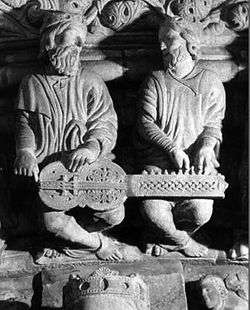
The column statues represent the apostles with their attribute; prophets and Old Testament figures with their name on a book or parchment. These were all polychromed. The faint smile of the prophet Daniel as he looks at the angel of Reims is especially noteworthy.

The middle pier represents Saint James, his face conveying an ecstatic serenity. The text scroll in his hand shows the words Misit me Dominus (the Lord sent me). Below him is the Tree of Jesse (the lineage leading to Christ), while above is a representation of the Trinity. It is customary for the pilgrims to touch the left foot of this statue, signifying that they have reached their destination. So many pilgrims have laid their hands on the pillar to rest, that a groove has been worn in the stone.
The lateral portals are dedicated to the Jews on the left and to the unbelievers on the right.
The right tympanum is divided into three parts and is dedicated to the salvation of the souls. In the centre are Christ and St Michael, flanked by Hell (represented by demons) and Heaven (represented by children). Purgatory is shown on the side. The left tympanum shows scenes from the Old Testament.
Demons are represented at the bottom of the pórtico, signifying that Glory crushes sin.
Behind the portico stands the statue of Maestro Mateo, the master architect and sculptor put in charge of the cathedral building programme in the 12th century by Fernando II. It is said that whoever butts their head three times against the statue will be given a portion of Mateo's genius[33] and perhaps enhanced memory. There is usually a long line of visitors waiting to bump their head against the statue.
The sculptures in this portico have been a point of reference for Galician sculpture until the 15th century.
The nave

The barrel-vaulted nave and the groin-vaulted aisles consist of eleven bays, while the wide transept consists of six bays. Every clustered pier is flanked by semi-columns, three of which carry the cross vaults of the side aisles and the truss of the arched vaults, while the fourth reaches to the spring of the vault. Lit galleries run, at a remarkable height, above the side aisles around the church.
The choir is covered by three bays and surrounded with an ambulatory and five radiating chapels. The vault of the apse is pierced by round windows, forming a clerestory. The choir displays a surprising exuberance in this Romanesque setting. An enormous baldachin, with a sumptuous decorated statue of Saint James from the 13th century, rises above the main altar. The pilgrims can kiss the saint's mantle via a narrow passage behind the altar.

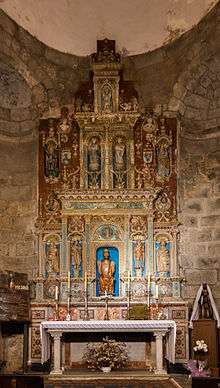
In the choir aisle the beautiful lattice work and the vault of the Mondragon chapel (1521) stand out. The radiating chapels constitute a museum of paintings, retables, reliquaries and sculptures, accumulated throughout the centuries. In the Chapel of the Reliquary (Galician: Capela do Relicario) is a gold crucifix, dated 874, containing an alleged piece of the True Cross.
Crypt

The crypt, below the main altar, shows the substructure of the 9th-century church. This was the final destination of the pilgrims. The crypt houses the relics of Saint James and two of his disciples : Saint Theodorus and Saint Athanasius. The silver reliquary (by José Losada, 1886) was put in the crypt at the end of the 19th century, after authentication of the relics by Pope Leo XIII in 1884.
Throughout the course of time, the burial place of the saint had been almost forgotten. Because of regular Dutch and English incursions, the relics had been transferred in 1589 from their place under the main altar to a safer place. They were rediscovered in January 1879.[34][35]
Botafumeiro

A dome above the crossing contains the pulley mechanism to swing the "Botafumeiro", which is a famous thurible found in this church. It was created by the goldsmith José Losada in 1851. The Santiago de Compostela Botafumeiro is the largest censer in the world, weighing 80 kg and measuring 1.60 m in height. It is normally on exhibition in the library of the cathedral, but during certain important religious high days it is attached to the pulley mechanism, filled with 40 kg of charcoal and incense. In the Jubilee Years, whenever St James's Day falls on a Sunday, the Botafumeiro is also attached in all the Pilgrims' Masses. Eight red-robed tiraboleiros pull the ropes and bring it into a swinging motion almost to the roof of the transept, reaching speeds of 80 km/h and dispensing thick clouds of incense. One explanation of this custom, which originated more than 700 years ago—although incense has been used in Catholic ritual from the earliest times—is that it assisted in masking the stench emanating from hundreds of unwashed pilgrims.
Other burials
- Alfonso Daniel Rodríguez Castelao, at the Panteón de Galegos Ilustres ("Pantheon of Illustrious Galicians"), Bonaval
- Fructuosus of Braga
- Rosalía de Castro
- Fernando Pérez de Traba
- Ferdinand II of León
- Alfonso IX of León
- Pedro Fernández de Castro
See also
References
- ↑ "Santiago de Compostela (Old Town)". Whc.unesco.org. Retrieved 2011-01-10.
- ↑ "Catedral Igrexa Catedral Metropolitana". Patrimonio Historico - Base de datos de bienes inmuebles (in Spanish). Ministerio de Cultura. Retrieved 9 January 2011.
- ↑ Orlandis, J. (1990). "Algunas consideraciones en torno a los orígenes cristianos en España". Cristianismo y aculturación en tiempos del imperio romano. Universidad de Murcia. pp. 63–71.
- ↑ Lligadas, J. (2005). El libro de los santos. Centro De Pastoral Liturgic. ISBN 8498050413.
- ↑ Franco Maside, R. y Pereira Menaut, G. (2005). "Muerte Y Ritual Funerario en la Historia de Galicia". SEMATA. Ciencias Sociais e Humanidades (in Galician) (Universidad de Santiago de Compostela) 17: 35–60. ISSN 1137-9669.
- ↑ Portela Silva 2003: p. 54
- ↑ Garrido Torres 2000: p. 100
- ↑ Garrido Torres 2000: p. 101
- 1 2 Bravo Lozano 1999: p. 235
- ↑ Armesto, V. (1971). Galicia feudal (2ª ed.). Editorial Galaxia. pp. 188, 287.
- ↑ Armesto, V. (1971). Galicia feudal (2ª ed.). publisher Galaxia. pp. 188 y 287.
- ↑ Vázquez/Yzquierdo/García/Castro 1996: pp. 76-77
- 1 2 3 "Pórtico de la Gloria y el Maestro Mateo". Románico en La Coruña. Arteguias. Retrieved 2010-10-17.
- ↑ "El Maestro Mateo o el Santo dos Croques". El camino de Santiago. Centro virtual Cervantes. Retrieved 2010-10-17.
- ↑ "La Catedral Metropolitana". Pórtico de la Gloria. Portal de la Archidiócesis de Santiago de Compostela. Retrieved 2010-10-17.
- ↑ "El Pórtico de la Gloria, Alzado". Rincones de Santiago. Retrieved 2010-10-17.
- ↑ "Fachada del workdoiro". Rincones de Santiago. Retrieved 2010-10-17.
- ↑ Bendala Galán, Manuel (2003). Manual del Arte Espyearl. Madrid: Silex. pp. 542–543. ISBN 84-7737-099-0.
- 1 2 3 4 5 6 7 Navascués 1997: p. 223
- ↑ "Fachada de Platerías". Fundación Barrie. Archived from the original on 2009-07-01.
- ↑ García Guinea, M. A. (1998). Vida cotidiana en la España medieval: actas del VI Curso de Cultura Medieval, celebrado en Aguilar de Campóo (Palencia) del 26 al 30 de septiembre de 1994. Santa María la Real. pp. 133–134. ISBN 8486547466.
- ↑ Belda Navarro, Cristóbal (1997). Los siglos del barroco. Madrid: Akal. p. 116. ISBN 84-460-0735-5.
- ↑ "Exteriores: fachadas e prazas". Catedral. Percorrido da Catedral (in Galician). Web oficial de turismo de Santiago de Compostela. Retrieved 2010-10-18.
- ↑ "Santiago de Compostela" (in Galician). RuralPoint Turismo Rural. Retrieved 2010-10-18.
- ↑ Vila, Mª Dolores. "Vega y Verdugo y la introducción del Barroco". Artehistoria Revista Digital. Junta de Castilla y León. ISSN 1887-4398. Retrieved 2010-10-19.
- ↑ Otero Pedrayo 1965: pp. 405-406
- ↑ "Catedral do Apóstolo Santiago - Santiago de Compostela (Galicia)". Inventario de las campanas de las Catedrales de España. Campaners de la Catedral de València. 2010. Retrieved 2010-10-19.
- 1 2 Vázquez Castro, J. (1998). "La Berenguela y la Torre del Reloj de la Catedral de Santiago". Semata Ciencias Socias E Humanidades (Universidad de Santiago de Compostela) 10: 111–148. ISSN 1137-9669.
- 1 2 "Santiago de Compostela. Catedral". Centro Virtual Cervantes. Retrieved 2010-10-19.
- ↑ Llop i Bayo, Francesc (2010). "La torre del reloj de la catedral". Campaners de la Catedral de València. Retrieved 2010-10-20.
- ↑ Pedrals, Joan (2010). "Les campanes originals del rellotge de la Catedral de Santiago de Compostela" (in Catalan). Campaners de la Catedral de València. Retrieved 2010-10-20.
- ↑ Lonely Planet: Spain. 4th Ed. 2003
- ↑ Llorca Vives, B.; García Villoslada, R.; Montalbán, F. J. (1960). Historia de la Iglesia Católica en sus cuarto grandes edades: Edad antigua (1-681). 1 de Historia de la Iglesia Católica en sus cuarto grandes edades: Antigua, media, nueva, moderna. Editorial Católica. p. 142.
- ↑ "Los years santos compostelanos del siglo XX. Crónica de un renacimiento" (PDF). Boletín Oficial del Arzobispado de Santiago (3594): 118–122. January 2005.
Bibliography
- Bravo Lozano, Millán (1999). Camino de Santiago Inolvidable. León: Everest. ISBN 84-241-3905-4.
- Carro Otero, Xosé (1997). Santiago de Compostela. publisher Everest. ISBN 84-241-3625-X.
- Chamorro Lamas, Manuel; González, Victoriano; Regal, Bernardo (1997). Rutas románicas en Galicia/1. Ediciones Encuentro. ISBN 84-7490-411-0.
- Fraguas Fraguas, Antonio (2004). Romerías y santuarios de Galicia. publisher Galaxia. p. 20. ISBN 978-84-8288-704-3.
- Fuertes Domínguez, Gregorio (1969). Guía de Santiago, sus monumentos, su arte. Depósito Legal C. 325-1969. El Eco Franciscano.
- García Iglesias, José Manuel (1993). A catedral de Santiago: A Idade Moderna (in Galician). Xuntanxa. ISBN 8486614694.
- Garrido Torres, Carlos (2000). Las Guías visuales de España: Galicia. Depósito legal: B 18469. El País.
- Gómez Moreno, María Elena (1947). Mil Joyas del Arte Espyearl, Piezas selectas, Monumentos magistrales: Tomo primero Antigüedad y Edad Media. Barcelona: Instituto Gallach.
- Navascués Palacio, Pedro; Sarthou Carreres, Carlos (1997). Catedrales de España. Edición especial para el Banco Bilbao Vizcaya. Madrid: Espasa Calpe. ISBN 84-239-7645-9. OCLC 249825366.
- Otero Pedrayo, Ramón (1965). Guía de Galicia (4ª ed.). publisher Galaxia. pp. 351ff.
- Portela Silva, E. (2003). Historia de la ciudad de Santiago de Compostela. Universidad de Santiago de Compostela. ISBN 8497501373.
- Sanmartín, Juan R. (1984). "O Botafumeiro: Parametric pumping in the Middle Ages". American Journal of Physics 52 (10): 937–945. doi:10.1119/1.13798.
- Vaqueiro, Vítor (1998). Guía da Galiza máxica, mítica e lendaria (in Galician). Galaxia. ISBN 8482882058.
- Vázquez Varela, J. M.; Yzquierdo Perrín, R.; García Iglesias, Castro, J. M. (1996). 100 works mestras da arte galega (in Galician). Nigra Arte. ISBN 84-87709-50-8.
- Villa-Amil y Castro, José (1866). Descripción histórico-artístico-arqueológica de la catedral de Santiago. Impr. de Soto Freire.
- Turner, Jane (1996). Grove Dictionary of Art. MacMillan Publishers Ltd. ISBN 0-19-517068-7.
- Cathedral video www.vimeo.com/27959788
- Botafumeiro https://www.youtube.com/watch?v=rOoHyEEXxoA
External links
| Wikimedia Commons has media related to Cathedral of Santiago de Compostela. |
- Official website
- Reconstruction of the swinging motion of the Botafumeiro
- Photographs of the Cathedral of Santiago de Compostela, Galicia, Spain
- Pictures of Cathedral of Santiago de Compostela
- HyperSculpture - Pórtico de la Gloria
- The Art of medieval Spain, A.D. 500-1200, an exhibition catalog from The Metropolitan Museum of Art Libraries (fully available online as PDF), which contains material on Santiago de Compostela Cathedral (p. 175-183)
| ||||||||||||||||||||||||||||||||||||||||||||||||||||
| |||||||||||||||||||||||||||||||||||||||||||||||||||||||||||||||||
|

